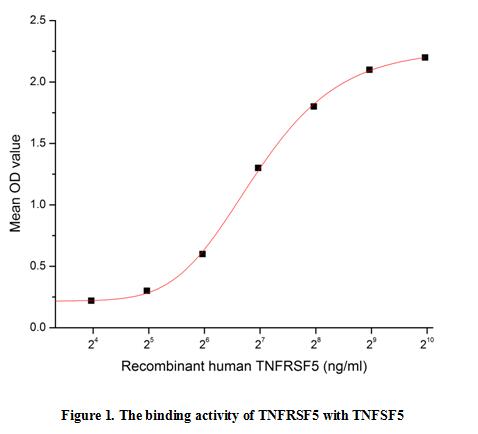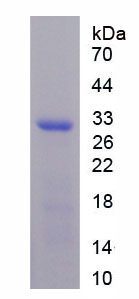Active Tumor Necrosis Factor Receptor Superfamily, Member 5 (CD40)
TNFRSF5; CDW40; Bp50; P50; B-cell surface antigen CD40; CD40L receptor
- Product No.APB249Hu61
- Organism SpeciesHomo sapiens (Human) Same name, Different species.
- Buffer FormulationPBS, pH7.4, containing 0.01% SKL, 1mM DTT, 5% Trehalose and Proclin300.
- Traits Freeze-dried powder
- Purity> 95%
- Isoelectric Point4.7
- ApplicationsCell culture; Activity Assays.
- DownloadInstruction Manual
- UOM 10µg50µg 200µg 1mg 5mg
- FOB
US$ 191
US$ 478
US$ 956
US$ 2868
US$ 7170
For more details, please contact local distributors!
ACTIVITY TEST

CD40, also known as Tumor Necrosis Factor Receptor Superfamily, Member 5 (TNFRSF5), is a 45-50 kDa type I transmembrane glycoprotein member of the TNF receptor superfamily. Mature human CD40 consists of a 173 amino acid (aa) extracellular domain, a transmembrane domain, and a 62 aa cytoplasmic domain. CD40 is expressed on the surface of B cells, dendritic cells, macrophages, monocytes and platelets, as well as endothelial and epithelial cells. Interaction of CD40 with its ligand, CD40 Ligand, leads to the aggregation of CD40 molecules resulting in the initiation of bidirectional intracellular signaling in both CD40 and CD40 Ligand expressing cells. A binding ELISA assay was conducted to detect the interaction of recombinant human TNFRSF5 and recombinant human TNFSF5. Briefly, TNFRSF5 was diluted serially in PBS with 0.01% BSA (pH 7.4). Duplicate samples of 100μl were then transferred to TNFSF5-coated microtiter wells and incubated for 1h at 37℃. Wells were washed with PBST and incubated for 1h with anti-TNFRSF5 pAb, then aspirated and washed 3 times. After incubation with HRP labelled secondary antibody for 1h at 37℃, wells were aspirated and washed 5 times. With the addition of substrate solution, wells were incubated 15-25 minutes at 37℃. Finally, add 50µL stop solution to the wells and read at 450/630nm immediately. The binding activity of TNFRSF5 and TNFSF5 was shown in Figure 1, the ED50 for this effect is 120 ng/mL.
USAGE
Reconstitute in 10mM PBS (pH7.4) to a concentration of 0.1-1.0 mg/mL. Do not vortex.
STORAGE
Avoid repeated freeze/thaw cycles. Store at 2-8°C for one month. Aliquot and store at -80°C for 12 months.
STABILITY
The thermal stability is described by the loss rate. The loss rate was determined by accelerated thermal degradation test, that is, incubate the protein at 37°C for 48h, and no obvious degradation and precipitation were observed. The loss rate is less than 5% within the expiration date under appropriate storage condition.
GIVEAWAYS
INCREMENT SERVICES
-
 BCA Protein Quantification Kit
BCA Protein Quantification Kit
-
 Molecular Mass Marker for Protein
Molecular Mass Marker for Protein
-
 Monoclonal Antibody Customized Service
Monoclonal Antibody Customized Service
-
 Polyclonal Antibody Customized Service
Polyclonal Antibody Customized Service
-
 Protein Activity Test Experiment Service
Protein Activity Test Experiment Service
-
 Electrophoretic Mobility Shift Assay (EMSA) Experiment Service
Electrophoretic Mobility Shift Assay (EMSA) Experiment Service
-
 Buffer
Buffer
-
 Lentivirus Packaging Experiment Service
Lentivirus Packaging Experiment Service
-
 Adenovirus Packaging Experiment Service
Adenovirus Packaging Experiment Service
-
 Real Time PCR Experimental Service
Real Time PCR Experimental Service
-
 Spike RBD Protein (S-RBD)
Spike RBD Protein (S-RBD)
-
 Protein G
Protein G
-
 Protein A
Protein A
| Magazine | Citations |
| american journal of physiology-renal physiology | The expression of XBP1s in B lymphocytes is critical for pristane-induced lupusnephritis in mice Pubmed: 32249615 |







